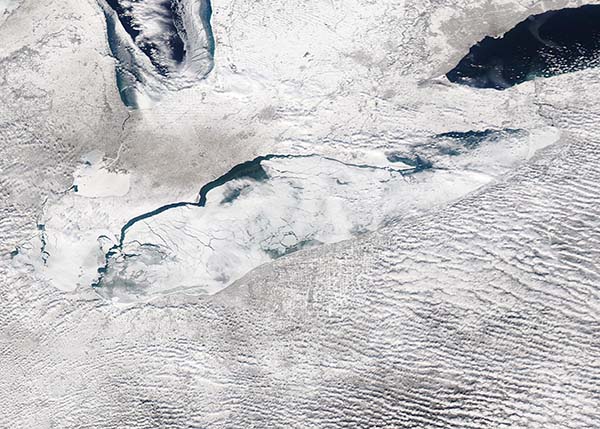Images
February 16, 2022 - Lake Erie's February Freeze
Tweet
Each year, frigid winter chill brings a topping of ice to the Great Lakes while wicked winter winds force thin ice to shift, breaking it up, and expanding the extent of open water. These wintery dynamics create a sort of dance across the largest lakes in North America, with ice growing and retreating based primarily on variations in wind and air temperature.
Since January 2022, the ice cover on Lake Erie has proven a case in point. In late January 2022, Lake Erie nearly froze over entirely, with ice cover growing well beyond the seasonal average to reach 94 percent. By February 3, the ice cover had dropped to about 62 percent before rising again to 90 percent by February 5. Another steep drop in ice occurred after that, with ice cover reaching about 55 percent on February 11 only to shoot back up to about 72 percent on February 14.
As the shallowest of the Great Lakes, Erie has the highest annual maximum ice cover, regularly reaching more than 80 percent. Three times in the past half century Lake Erie reached 100 percent ice cover: 1978, 1979, and 1996.
Conditions on the lake are not only highly variable from year to year, but also day to day. The first week of February 2022 brought a heavy snowstorm, wildly varying wind speeds and directions, and days of continuous cooling. As a result, the ice extent across the Great Lakes rapidly expanded. On February 1, the average ice cover across all the lakes was 12 percent; two days later it had expanded to 28 percent; and by February 6 it was 43 percent. (Between 1973–2021, the Great Lakes’ annual average maximum ice coverage was 53.1 percent.)
The Moderate Resolution Imaging Spectroradiometer (MODIS) on board NASA’s Aqua satellite acquired this true-color image of Lake Erie on February 14, 2022. Surrounded by snow and cloud, the lake was nearly covered with ice except for areas near the northern coasts where open water prevailed. Ice also covered much of the southern tip of Lake Huron while most of the western section of Lake Ontario remained ice-free.
Image Facts
Satellite:
Aqua
Date Acquired: 2/14/2022
Resolutions:
1km (89.4 KB), 500m (230.4 KB), 250m (585.8 KB)
Bands Used: 1,4,3
Image Credit:
MODIS Land Rapid Response Team, NASA GSFC
Tweet
Each year, frigid winter chill brings a topping of ice to the Great Lakes while wicked winter winds force thin ice to shift, breaking it up, and expanding the extent of open water. These wintery dynamics create a sort of dance across the largest lakes in North America, with ice growing and retreating based primarily on variations in wind and air temperature.
Since January 2022, the ice cover on Lake Erie has proven a case in point. In late January 2022, Lake Erie nearly froze over entirely, with ice cover growing well beyond the seasonal average to reach 94 percent. By February 3, the ice cover had dropped to about 62 percent before rising again to 90 percent by February 5. Another steep drop in ice occurred after that, with ice cover reaching about 55 percent on February 11 only to shoot back up to about 72 percent on February 14.
As the shallowest of the Great Lakes, Erie has the highest annual maximum ice cover, regularly reaching more than 80 percent. Three times in the past half century Lake Erie reached 100 percent ice cover: 1978, 1979, and 1996. Conditions on the lake are not only highly variable from year to year, but also day to day. The first week of February 2022 brought a heavy snowstorm, wildly varying wind speeds and directions, and days of continuous cooling. As a result, the ice extent across the Great Lakes rapidly expanded. On February 1, the average ice cover across all the lakes was 12 percent; two days later it had expanded to 28 percent; and by February 6 it was 43 percent. (Between 1973–2021, the Great Lakes’ annual average maximum ice coverage was 53.1 percent.)
The Moderate Resolution Imaging Spectroradiometer (MODIS) on board NASA’s Aqua satellite acquired this true-color image of Lake Erie on February 14, 2022. Surrounded by snow and cloud, the lake was nearly covered with ice except for areas near the northern coasts where open water prevailed. Ice also covered much of the southern tip of Lake Huron while most of the western section of Lake Ontario remained ice-free.
Image Facts
Satellite:
Aqua
Date Acquired: 2/14/2022
Resolutions:
1km (89.4 KB), 500m (230.4 KB), 250m (585.8 KB)
Bands Used: 1,4,3
Image Credit:
MODIS Land Rapid Response Team, NASA GSFC




